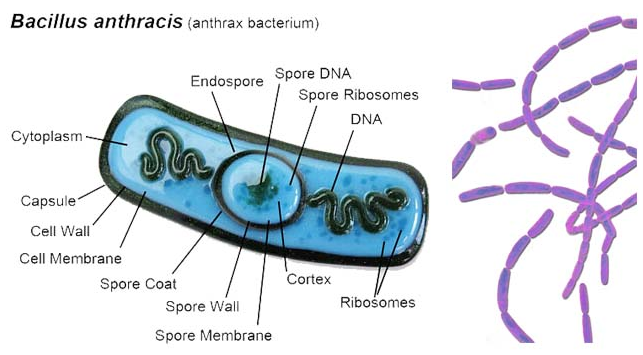
What is Anthrax Bacilli?
Anthrax Bacilli or Bacillus anthracis is a spore-forming bacterium and a dangerous pathogen that causes Anthrax disease. Bacillus anthracis mainly affects livestock and wild game. Humans too can become infected through direct or indirect contact with sick animals. Usually the bacteria enter the body through a wound in the skin or through eating contaminated meat, drinking contaminated water or inhaling the spores. There is actually no evidence that anthrax can be transmitted from person to person, but it is possible that anthrax skin lesions may be contagious through direct contact.
Signs and symptoms usually depend on the severity of the infection and can range from skin sores to vomiting to sock.
What Is Anthracoid Bacilli?
Anthracoid Bacilli or Pseudoanthrax bacilli are Bacillus species that have a closer look (resemble) Bacillus anthracis. These are the opportunistic pathogens with low virulence. They are usually present in almost all environments. Some of which are frequent laboratory contaminants. Some of the anthracoid species include:
- Bacillus cereus which is a pathogen that causes ocular infections and catheter-related infections.
- Bacillus subtilis which is an opportunistic pathogen that causes eye infection and septicemia.
- Bacillus licheniformis which is also an opportunistic pathogen that causes food poisoning.
- Bacillus stearothermophilus whose spores are used to test the efficiency of sterilization by autoclaves.
- More importantly, some species of anthracoid bacilli are used for production of antibiotics such as polymyxin, tyrothri-cin and bacitracin.
Also Read: Difference Between staphylococcus and Streptococcus
The Differences Between Anthrax Bacilli and Anthracoid Bacilli In Tabular Form
| Basis of Comparison | Anthrax Bacilli | Anthracoid Bacilli |
| Turbidity | The movement of anthrax bacilli does not create a uniform cloudiness (turbidity) in broth. | The movement of anthracoid bacilli usually creates a uniform cloudiness (turbidity) in the broth. |
| Motility | Anthrax Bacilli are non-motile. | Anthracoid Bacilli are very motile due to presence of flagella. |
| Capsule | Anthrax Bacilli have the capsule ( K antigen) which is a virulence factor that enhances the ability of bacteria to cause diseases. The capsule also protects cells from engulfment by eukaryotic cells such as macrophages.Capsule also contains water which protects the bacteria against desiccation. | Anthracoid bacilli are non-capsulated (do not have the virulence factor that enhances the ability of bacteria to cause diseases. |
| Shape | The anthrax bacilli are rod-shaped and grow in long chains. | The anthracoid bacilli are rod-shaped and grow in short chains. |
| Medusa Head Colony | Colonies are nonhemolytic, flat or slightly convex with irregular edges and ground-glass appearance. Medusa head colony is present in anthrax bacilli. | Medusa head colony is absent in anthracoid bacilli. |
| Growth in Penicillin Agar (10 units/ml) | An anthrax bacillus does not grow in penicillin agar. | Anthracoid bacilli usually grow in penicillin agar. |
| Gelatin Liquefaction | Slow Gelatin liquefaction. | Rapid Gelatin Liquefaction. |
| Chloral Hydrate | Growth inhibited by chloral hydrate. | Growth not inhibited by Chloral hydrate. |
| Gamma Phage | Susceptible to Gamma phage. | Not susceptible to Gamma phage. |
| Diseases Caused | Cutaneous anthrax Gastrointestinal anthrax Inhalational anthrax Anthrax meningitis | Ocular infections and cather-related infections. Eye infections and septicemia. Food poisoning. |
| Reduction of Methylene blue in Milk | Reduction of methylene blue in milk is quite slow. | Reduction of methylene blue in milk is quite rapid. |
| Pathogenesis | Pathogenic | Most of them are non-pathogenic or opportunistic pathogens with low virulence. |
| Salicin Fermentation | Negative. | Always positive. |
| Blood Agar | No hemolysis | Hemolytic colonies (usually well marked). |
| Oxygen requirement | Strict aerobe | Aerobic or facultative anaerobes. |
Also Read: Difference Between Shigella and Salmonella